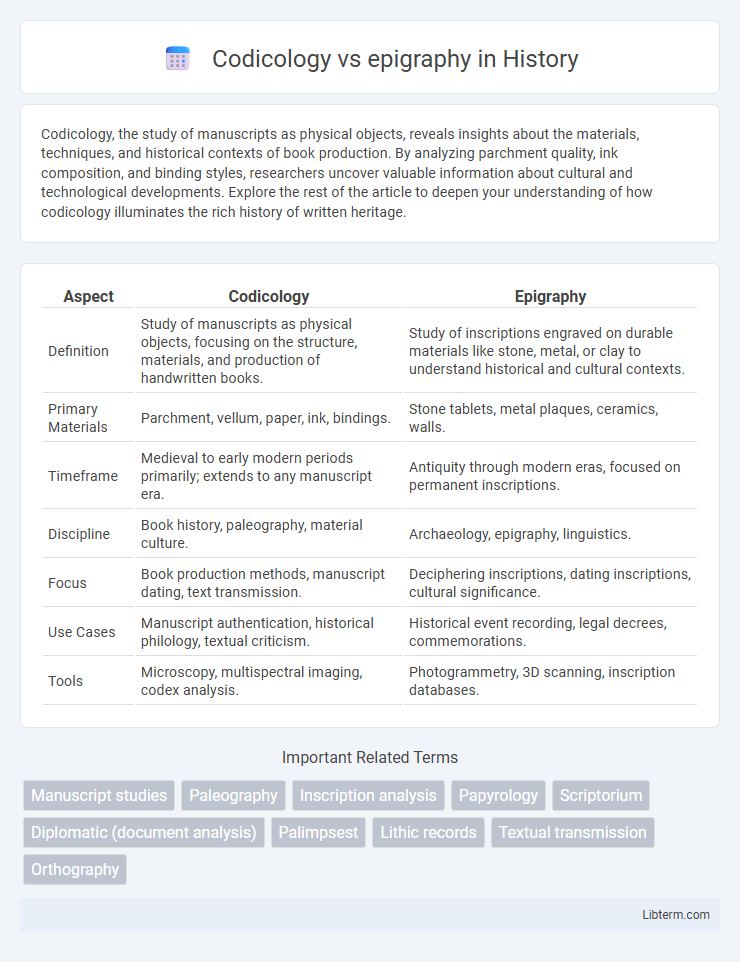Codicology, the study of manuscripts as physical objects, reveals insights about the materials, techniques, and historical contexts of book production. By analyzing parchment quality, ink composition, and binding styles, researchers uncover valuable information about cultural and technological developments. Explore the rest of the article to deepen your understanding of how codicology illuminates the rich history of written heritage.
Table of Comparison
| Aspect | Codicology | Epigraphy |
|---|---|---|
| Definition | Study of manuscripts as physical objects, focusing on the structure, materials, and production of handwritten books. | Study of inscriptions engraved on durable materials like stone, metal, or clay to understand historical and cultural contexts. |
| Primary Materials | Parchment, vellum, paper, ink, bindings. | Stone tablets, metal plaques, ceramics, walls. |
| Timeframe | Medieval to early modern periods primarily; extends to any manuscript era. | Antiquity through modern eras, focused on permanent inscriptions. |
| Discipline | Book history, paleography, material culture. | Archaeology, epigraphy, linguistics. |
| Focus | Book production methods, manuscript dating, text transmission. | Deciphering inscriptions, dating inscriptions, cultural significance. |
| Use Cases | Manuscript authentication, historical philology, textual criticism. | Historical event recording, legal decrees, commemorations. |
| Tools | Microscopy, multispectral imaging, codex analysis. | Photogrammetry, 3D scanning, inscription databases. |
Introduction to Codicology and Epigraphy
Codicology examines the physical structure and materials of handwritten manuscripts, focusing on the analysis of parchment, ink, and binding techniques to understand the historical production of texts. Epigraphy studies inscriptions engraved on durable materials like stone or metal, revealing linguistic, cultural, and historical contexts through deciphering ancient scripts. Both disciplines provide critical insights into the preservation and interpretation of historical documents, with codicology emphasizing manuscript transmission and epigraphy concentrating on inscribed texts in public or monumental settings.
Defining Codicology: The Study of Manuscripts
Codicology is the scientific study of manuscripts as physical objects, analyzing materials such as parchment, ink, and binding to understand their historical context and production techniques. It differs from epigraphy, which focuses on inscriptions carved or etched on durable surfaces like stone or metal. By examining the codex structure, script, and annotations, codicology reveals insights into medieval bookmaking, provenance, and textual transmission.
Understanding Epigraphy: The Study of Inscriptions
Epigraphy centers on the analysis and interpretation of inscriptions engraved on materials such as stone, metal, or pottery, providing critical insights into ancient languages, cultures, and historical events. Unlike codicology, which examines manuscripts and handwritten texts to trace the history of book production and script evolution, epigraphy reveals public, religious, and commemorative messages that illuminate societal values and governance. Studying epigraphic evidence enhances our understanding of chronological frameworks, linguistic development, and archaeological contexts integral to reconstructing past civilizations.
Historical Origins and Development
Codicology, the study of manuscript books, originated in the Middle Ages as scholars sought to understand the physical construction and historical context of handwritten texts, emphasizing the analysis of materials like parchment, ink, and script. Epigraphy, focusing on ancient inscriptions engraved on durable materials such as stone, metal, or clay, developed from classical archaeology and philology, aiming to decode and interpret public and monumental texts from civilizations like Mesopotamia, Egypt, and Greece. Both disciplines evolved through interdisciplinary research, with codicology enhancing the study of medieval book culture and epigraphy illuminating the sociopolitical and linguistic history of antiquity.
Core Methodologies in Codicology
Codicology centers on the physical examination of manuscripts, analyzing materials such as parchment, ink, script styles, and binding techniques to uncover historical and cultural contexts. Key methodologies include detailed codex structure assessment, quire analysis, and paleographic scrutiny, which contribute to understanding the origins and transmission of texts. Epigraphy, by contrast, emphasizes the study of inscriptions engraved on materials like stone or metal, focusing on deciphering textual content and linguistic features rather than manuscript construction.
Key Techniques in Epigraphic Analysis
Epigraphic analysis employs techniques such as stone surface examination, inscription transcription, and paleographic dating to decode historical texts engraved on materials like stone, metal, or pottery. Photogrammetry and 3D scanning enhance the visualization of weathered inscriptions, aiding in accurate interpretation and preservation. These methods contrast with codicology's focus on manuscript construction, providing unique insights into ancient cultures through permanently inscribed records.
Types of Materials and Media Examined
Codicology studies manuscripts primarily on parchment, vellum, and paper, analyzing their physical structure, binding, and script. Epigraphy examines inscriptions carved or engraved on durable materials such as stone, metal, clay, and ceramics, focusing on the medium's durability and context. Both fields provide insights into historical communication but differ significantly in the materials and media scrutinized.
Applications in Historical Research
Codicology examines the physical characteristics of manuscripts to reveal insights about the production, provenance, and usage of historical texts, aiding in dating and authenticating documents. Epigraphy analyzes inscriptions engraved on durable materials such as stone or metal, providing direct evidence of cultural, political, and social practices in ancient civilizations. Both disciplines complement each other by offering distinct data sources that enhance the understanding of historical contexts and textual transmission.
Challenges and Limitations in Each Field
Codicology faces challenges related to the physical preservation and dating of manuscripts, where deterioration and incomplete texts complicate accurate historical analysis. Epigraphy encounters limitations in interpreting weathered or fragmented inscriptions, often hindered by linguistic ambiguities and contextual gaps that restrict precise understanding. Both fields require advanced technologies and multidisciplinary approaches to overcome these obstacles and enhance the reliability of manuscript and inscription studies.
Future Directions and Interdisciplinary Approaches
Future directions in codicology emphasize the integration of digital imaging technologies and machine learning algorithms to analyze manuscript materials, enabling more precise dating and provenance studies. Epigraphy increasingly leverages 3D scanning and AI-driven text recognition to enhance the study of inscriptions on various surfaces, facilitating broader accessibility and preservation. Combining codicology and epigraphy through interdisciplinary approaches fosters a holistic understanding of textual artifacts, linking manuscript traditions with inscribed records for comprehensive cultural and historical insights.
Codicology Infographic

 libterm.com
libterm.com